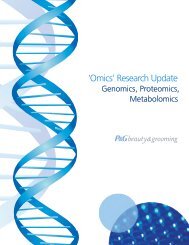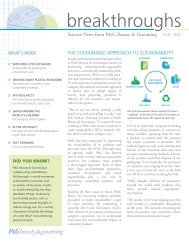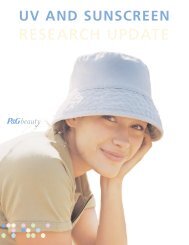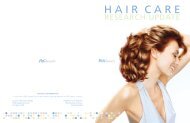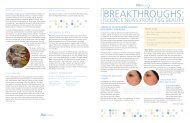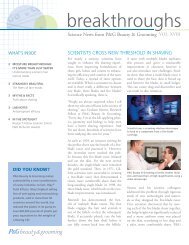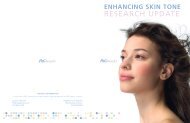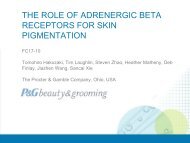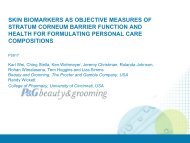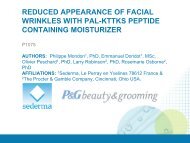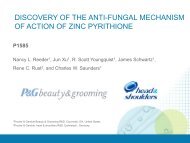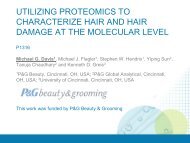Fine Lines, Wrinkles & Texture Research Update - P&G Beauty ...
Fine Lines, Wrinkles & Texture Research Update - P&G Beauty ...
Fine Lines, Wrinkles & Texture Research Update - P&G Beauty ...
You also want an ePaper? Increase the reach of your titles
YUMPU automatically turns print PDFs into web optimized ePapers that Google loves.
Gene Chip Technology<br />
One new technology that has been<br />
developed as an outgrowth of the<br />
sequencing of the human genome is<br />
a gene-monitoring device known as<br />
the gene chip. Th e gene chip’s versatile<br />
technology has led to it being<br />
used by researchers studying various<br />
diseases including autism, bipolar<br />
disease, cancer, diabetes and heart<br />
disease. In addition to these applications,<br />
the gene chip technology is<br />
enabling P&G <strong>Beauty</strong> researchers to<br />
understand the underlying biological<br />
basis of changes seen on the skin surface,<br />
including changes in fi ne lines<br />
and wrinkles.<br />
Th e chip itself has indicators that represent<br />
genes comprising the human<br />
genome. By placing fragments of<br />
Tiled onto an Affymetrix gene chip are oligonucleatide<br />
probes representing over 35,000 genes.This<br />
technology has revolutionized genomics research<br />
and is being used extensively by P&G <strong>Beauty</strong><br />
scientists.<br />
fl uorescently-tagged samples isolated<br />
from the skin onto the chip, scientists<br />
can see which genes are expressed<br />
within the sample and whether these<br />
genes are up-regulated or down-regulated,<br />
indicating specifi c molecular<br />
events contributing to a given biological<br />
process.<br />
Advances in Preclinical<br />
& Clinical Testing<br />
Along the long road from molecular<br />
to preclinical and fi nally clinical testing<br />
at P&G <strong>Beauty</strong>, ingredients and<br />
their subsequent product applications<br />
must pass clear safety and effi -<br />
cacy benchmarks before even being<br />
considered for market introduction.<br />
Beginning with testing on in vitro<br />
skin equivalents and advancing to in<br />
vivo effi cacy testing, these measurements<br />
have elevated the legitimacy of<br />
skin care science and the rigor upon<br />
which skin care claims are made.<br />
In vitro Human Skin Equivalents<br />
Th e imperative for skin product<br />
safety, combined with ethical, social<br />
and political pressures, has fostered<br />
improvements in alternatives for animal<br />
testing. One of the leading technologies<br />
that has been developed is<br />
human skin equivalent culture models.<br />
In recent years, advancements in<br />
techniques have led to cultures that<br />
mimic not only the epidermal layer<br />
but also the dermal layer, allowing<br />
these models to be used not only for<br />
safety assessments22 but also to test<br />
23, 24, 25<br />
product effi cacy.<br />
In vitro human skin equivalents reproduce many<br />
cellular and structural elements of natural skin,<br />
including the dermis, epidermis and melanocytes.<br />
Human skin equivalent cultures receive nutrients<br />
from the bottom of the culture. This facilitates<br />
application of topical ingredients, both water<br />
soluble and non-water soluble, on the top of the<br />
culture.<br />
Today’s human skin equivalents off er<br />
multiple advantages over traditional<br />
monolayer cultures:<br />
• Can be used to test undiluted<br />
materials (e.g., product formulations)<br />
which is important because<br />
not all materials are water-soluble<br />
• Are able to show cell-to-cell<br />
interaction between dermis and<br />
epidermis<br />
• Clinically relevant measures can<br />
be performed (e.g., barrier eff ects<br />
with TEWL, hydration)<br />
<strong>Fine</strong> <strong>Lines</strong>, <strong>Wrinkles</strong> & <strong>Texture</strong>: <strong>Research</strong> <strong>Update</strong> 7




